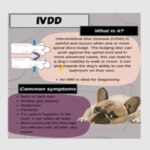IVDD in Dogs Treatment: Home Care Tips for Recovery
Caring for a dog diagnosed with Intervertebral Disc Disease can feel overwhelming at first. IVDD in dogs treatment does not end at the veterinary clinic. Much of the healing process takes place at home, where owners play a key role in recovery. With the right home care plan, supported by professional guidance and IVDD therapy, many dogs regain comfort, mobility, and a good quality of life.
Creating a Safe Home Environment
A supportive environment is essential for dogs with IVDD. The spine must be protected from unnecessary strain, and owners can make simple changes to reduce risks. Non-slip rugs or mats should be placed on slippery floors to prevent falls. Ramps can replace stairs, making it easier for dogs to access furniture or vehicles without jumping. Orthopedic beds provide proper support for the back, ensuring the spine stays aligned while resting.
Crate Rest and Controlled Activity
For dogs undergoing conservative IVDD treatment, crate rest is often prescribed for four to six weeks. This limits movement and allows the damaged disc to heal. While it may seem restrictive, rest is crucial for recovery. Dogs should only leave the crate for bathroom breaks or short, controlled walks. As healing progresses, activity levels can be slowly increased under veterinary supervision.
Managing Pain and Comfort
Medication prescribed by a veterinarian helps manage inflammation and discomfort. Consistent pain control not only makes the dog more comfortable but also supports healing. Owners should follow the medication schedule carefully and never adjust dosages without professional advice.
Adding supportive devices, such as harnesses designed for spinal conditions, also helps reduce strain during walks. These tools provide better control and stability, especially for dogs who are weak or unsteady.
Incorporating IVDD Therapy at Home
Professional rehabilitation plays a vital role in recovery, but many exercises can be continued at home to complement clinic-based care. IVDD therapy often includes:
-
Gentle stretching: Helps maintain flexibility and reduce stiffness.
-
Balance exercises: Using wobble boards or cushions to rebuild stability.
-
Hydrotherapy: If available, swimming in safe, shallow water supports low-impact exercise.
-
Massage: Encourages circulation, reduces muscle tension, and provides comfort.
Consistency is key. Daily sessions, even if brief, can make a noticeable difference in a dog’s progress.
Nutrition and Weight Management
Excess weight places strain on the spine, making weight management an important part of IVDD treatment. Feeding a balanced diet and avoiding excessive treats helps dogs maintain a healthy body condition. Supplements such as omega-3 fatty acids or joint support formulas may also be recommended by veterinarians to support spinal health.
Monitoring Progress
Owners should keep a daily record of symptoms, mobility, and behavior. Improvements may be gradual, but small changes such as increased stability or reduced pain are positive signs. If symptoms worsen, immediate veterinary consultation is necessary. Sudden loss of mobility, in particular, requires urgent attention.
Emotional Support for Dogs
Recovery is not only physical. Dogs with restricted activity can become bored or anxious. Providing mental stimulation through puzzle toys, gentle interaction, and calm companionship helps keep them engaged. Patience and encouragement from owners also play a powerful role in supporting recovery.
Preventing Future Injuries
Even after recovery, dogs with IVDD remain at risk for reinjury. Preventive measures are essential to protect the spine long-term. Regular, low-impact exercise maintains strength and mobility. Owners should avoid activities that involve jumping or sudden twisting movements. Continuing light IVDD therapy as part of daily routines can also prevent stiffness and maintain muscle tone.
Final Thoughts
IVDD in dogs treatment requires a combination of veterinary care, rehabilitation, and dedicated home support. With proper rest, safe environments, pain management, and structured IVDD therapy, many dogs recover well and return to an active life. Owners who remain consistent and attentive provide their pets with the best possible chance for healing and long-term comfort.

